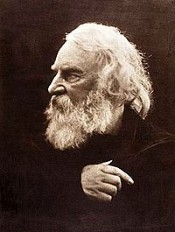Hayman Doris

Henry Wadsworth Longfellow (February 27, 1807 – March 24, 1882) was an American educator and poet whose works include "Paul Revere's Ride", The Song of Hiawatha, and "Evangeline". He was also the first American to translate Dante Alighieri's The Divine Comedy and was one of the five Fireside Poets. Longfellow was born in Portland, Maine, then part of Massachusetts, and studied at Bowdoin College. After spending time in Europe he became a professor at Bowdoin and, later, at Harvard College. His first major poetry collections were Voices of the Night (1839) and Ballads and Other Poems (1841). Longfellow retired from teaching in 1854 to focus on his writing, living the remainder of his life in Cambridge, Massachusetts, in a former headquarters of George Washington. His first wife, Mary Potter, died in 1835 after a miscarriage. His second wife, Frances Appleton, died in 1861 after sustaining burns from her dress catching fire. After her death, Longfellow had difficulty writing poetry for a time and focused on his translation. He died in 1882. Longfellow predominantly wrote lyric poems which are known for their musicality and which often presented stories of mythology and legend. He became the most popular American poet of his day and also had success overseas. He has been criticized, however, for imitating European styles and writing specifically for the masses. Longfellow was born on February 27, 1807, to Stephen Longfellow and Zilpah (Wadsworth) Longfellow in Portland, Maine,[1] then a district of Massachusetts,[2] and he grew up in what is now known as the Wadsworth-Longfellow House. His father was a lawyer, and his maternal grandfather, Peleg Wadsworth, was a general in the American Revolutionary War and a Member of Congress.[3] He was named after his mother's brother Henry Wadsworth, a Navy lieutenant who died only three years earlier at the Battle of Tripoli.[4] Young Longfellow was the second of eight children;[5] his siblings were Stephen (1805), Elizabeth (1808), Anne (1810), Alexander (1814), Mary (1816), Ellen (1818), and Samuel (1819). Henry Wadsworth Longfellow was enrolled in a dame school at the age of three and by age six was enrolled at the private Portland Academy. In his years there, he earned a reputation as being very studious and became fluent in Latin.[6] His mother encouraged his enthusiasm for reading and learning, introducing him to Robinson Crusoe and Don Quixote.[7] He printed his first poem — a patriotic and historical four stanza poem called "The Battle of Lovell's Pond" — in the Portland Gazette on November 17, 1820.[8] He stayed at the Portland Academy until the age of fourteen. He spent much of his summers as a child at his grandfather Peleg's farm in the western Maine town of Hiram. In the fall of 1822, the 15-year old Longfellow enrolled at Bowdoin College in Brunswick, Maine, alongside his brother Stephen.[6] His grandfather was a founder of the college[9] and his father was a trustee.[6] There, Longfellow met Nathaniel Hawthorne, who would later become his lifelong friend.[10] He boarded with a clergyman for a time before rooming on the third floor of what is now Maine Hall in 1823.[11] He joined the Peucinian Society, a group of students with Federalist leanings.[12] In his senior year, Longfellow wrote to his father about his aspirations: I will not disguise it in the least... the fact is, I most eagerly aspire after future eminence in literature, my whole soul burns most ardently after it, and every earthly thought centres in it... I am almost confident in believing, that if I can ever rise in the world it must be by the exercise of my talents in the wide field of literature.[13] He pursued his literary goals by submitting poetry and prose to various newspapers and magazines, partly due to encouragement from a professor named Thomas Cogswell Upham.[14] Between January 1824 and his graduation in 1825, he had published nearly 40 minor poems.[15] About 24 of them appeared in the short-lived Boston periodical The United States Literary Gazette.[12] When Longfellow graduated from Bowdoin, he was ranked fourth in the class, and had been elected to Phi Beta Kappa.[16] He gave the student commencement address.[14] After graduating in 1825, he was offered a job as professor of modern languages at his alma mater. The story, possibly apocryphal, is that an influential trustee, Benjamin Orr, had been so impressed by Longfellow's translation of Horace that he was hired under the condition that he travel to Europe to study French, Spanish, and Italian.[17] Whatever the motivation, he began his tour of Europe in May 1826 aboard the ship Cadmus.[18] His time abroad would last three years and cost his father $2,604.24.[19] He traveled to France, Spain, Italy, Germany, back to France, then England before returning to the United States in mid-August 1829.[20] While overseas, he learned French, Spanish, Portuguese, and German, mostly without formal instruction.[21] In Madrid, he spent time with Washington Irving and was particularly impressed by the author's work ethic.[22] Irving encouraged the young Longfellow to pursue writing.[23] While in Spain, Longfellow was saddened to learn his favorite sister, Elizabeth, had died of tuberculosis at the age of 20 that May while he was abroad.[24] On August 27, 1829, he wrote to the president of Bowdoin that he was turning down the professorship because he considered the $600 salary "disproportionate to the duties required". The trustees raised his salary to $800 with an additional $100 to serve as the college's librarian, a post which required one hour of work per day.[25] During his years teaching at the college, he wrote textbooks in French, Italian, and Spanish;[26] his first published book was in 1833, a translation of the poetry of medieval Spanish poet Jorge Manrique.[27] He also published a travel book, Outre-Mer: A Pilgrimage Beyond the Sea, first published in serial form before a book edition was released in 1835.[26] Shortly after the book's publication, Longfellow attempted to join the literary circle in New York and asked George Pope Morris for an editorial role at one of Morris's publications. Longfellow was considering moving to New York after New York University considered offering him a newly-created professorship of modern languages, though there would be no salary. The professorship was not created and Longfellow agreed to continue teaching at Bowdoin.[28] Nevertheless, he did not enjoy his time at Bowdoin, especially correcting exams and papers. He wrote, "I hate the sight of pen, ink, and paper... I do not believe that I was born for such a lot. I have aimed higher than this".[29] On September 14, 1831, Longfellow married Mary Storer Potter, a childhood friend from Portland.[30] The couple settled in Brunswick, though the two were not happy there.[31] Longfellow published several nonfiction and fiction prose pieces inspired by Irving, including "The Indian Summer" and "The Bald Eagle" in 1833.[32] In December 1834, Longfellow received a letter from Josiah Quincy III, president of Harvard College, offering him the Smith Professorship of Modern Languages position with the stipulation that he spend a year or so abroad.[33] There, he further studied German as well as Dutch, Danish, Swedish, Finnish, and Icelandic.[34] In October 1835, during the trip, his wife Mary had a miscarriage about six months into her pregnancy.[35] She did not recover and died after several weeks of illness at the age of 22 on November 29, 1835. Longfellow had her body embalmed immediately and placed into a lead coffin inside an oak coffin which was then shipped to Mount Auburn Cemetery near Boston.[36] He was deeply saddened by her death, writing "One thought occupies me night and day... She is dead—She is dead! All day I am weary and sad".[37] Three years later, he was inspired to write the poem "Footsteps of Angels" about her. Several years later, he wrote the poem "Mezzo Cammin" to express his sorrow over her death.[38] When he returned to the United States in 1836, Longfellow took up the professorship at Harvard. He was required to live in Cambridge to be close to the campus and rented rooms at the Craigie House in the spring of 1837,[39] now preserved as the Longfellow National Historic Site. The home, built in 1759, had once been the headquarters of George Washington during the Siege of Boston beginning in July 1775.[40] Previous boarders also included Jared Sparks, Edward Everett, and Joseph Emerson Worcester.[41] Longfellow began publishing his poetry, including the collection Voices of the Night in 1839.[42] The bulk of Voices of the Night, Longfellow's debut book of poetry, was translations though he also included nine original poems and seven poems he had written as a teenager.[43] Ballads and Other Poems was published shortly thereafter in 1841[44] and included "The Village Blacksmith" and "The Wreck of the Hesperus", which were instantly popular.[45] Longfellow also became part of the local social scene, creating a group of friends who called themselves the Five of Clubs. Members included Cornelius Conway Felton, George Stillman Hillard, and Charles Sumner, the latter of whom would become Longfellow's closest friend over the next 30 years.[46] As a professor, Longfellow was well-liked, though he disliked being "constantly a playmate for boys" rather than "stretching out and grappling with men's minds."[47] Longfellow began courting Frances "Fanny" Appleton, the daughter of a wealthy Boston industrialist, Nathan Appleton[48] and sister of Thomas Gold Appleton. At first, she was not interested but Longfellow was determined. In July 1839, he wrote to a friend: "[V]ictory hangs doubtful. The lady says she will not! I say she shall! It is not pride, but the madness of passion".[49] His friend George Stillman Hillard encouraged Longfellow in the pursuit: "I delight to see you keeping up so stout a heart for the resolve to conquer is half the battle in love as well as war".[50] During the courtship, Longfellow frequently walked from Cambridge to the Appleton home in Beacon Hill in Boston by crossing the Boston Bridge. That bridge was replaced in 1906 by a new bridge which was later renamed the Longfellow Bridge.
do you like this author?
What readers are saying
What do you think? Write your own comment on this book!
write a commentWhat readers are saying
What do you think? Write your own comment on this author!
write a commentBook list

The Children's Longfellow
Series:
Unknown
Year:
Unknown
Raiting:
3.5/5
excerpt from the book..The home of the American poet, Henry Wadsworth Longfellow, during thegreater part of his life was in the picturesque town of Cambridge,Massachusetts, and there many of his best known poems were written.The forge of the Village Blacksmith really stood there beneath theshelter of a "spreading chestnut tree," in Cambridge, and when, as thetown grew larger, the smithy was removed and the tree cut down, all theschool children in Cambridge subscribed together to buy the wood of thefamous tree and had a chair made from it which they gave to the poet.
Show more
add to favoritesadd In favorites
Book list

The Children's Longfellow
Series:
Unknown
Year:
Unknown
Raiting:
3.5/5
excerpt from the book..The home of the American poet, Henry Wadsworth Longfellow, during thegreater part of his life was in the picturesque town of Cambridge,Massachusetts, and there many of his best known poems were written.The forge of the Village Blacksmith really stood there beneath theshelter of a "spreading chestnut tree," in Cambridge, and when, as thetown grew larger, the smithy was removed and the tree cut down, all theschool children in Cambridge subscribed together to buy the wood of thefamous tree and had a chair made from it which they gave to the poet.
Show more
add to favoritesadd In favorites
What readers are saying
What do you think? Write your own comment on this author!
write a commentif you like Hayman Doris try:
readers also enjoyed
What readers are saying
What do you think? Write your own comment on this author!
write a commentif you like Hayman Doris try:
readers also enjoyed
Do you want to exchange books? It’s EASY!
Get registered and find other users who want to give their favourite books to good hands!


